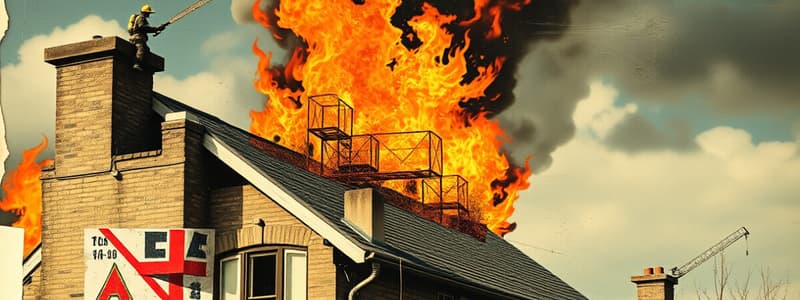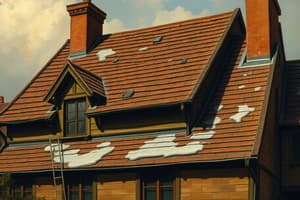Podcast
Questions and Answers
What should the Roof Sector Officer primarily focus on when assessing roof conditions?
What should the Roof Sector Officer primarily focus on when assessing roof conditions?
- Pre-existing water damage on the roof
- The types of roofing materials used in surrounding buildings
- The structural stability related to changing fire conditions (correct)
- The decorative aspects of the roof design
Which of the following is an objective of Roof Sector operations?
Which of the following is an objective of Roof Sector operations?
- Complete ventilation cuts for effective ventilation (correct)
- Documenting all decorative features of the roof
- Initiating a controlled fire within the structure
- Restricting access to the roof area for safety reasons
When is it appropriate for the Roof Sector Officer to cut additional ventilation holes?
When is it appropriate for the Roof Sector Officer to cut additional ventilation holes?
- As long as the first hole remains open and clear (correct)
- Immediately upon arrival at the scene
- Once a safe and stable roof area is confirmed
- Only after the fire has been fully extinguished
What information must the Roof Sector Officer report to Command after ventilation holes are completed?
What information must the Roof Sector Officer report to Command after ventilation holes are completed?
Which piece of equipment must all Roof Sector personnel wear while operating above a fire?
Which piece of equipment must all Roof Sector personnel wear while operating above a fire?
What should crews do after cutting the first ventilation hole?
What should crews do after cutting the first ventilation hole?
Why might a Roof Sector need to be established in a position remote from the fire-involved roof?
Why might a Roof Sector need to be established in a position remote from the fire-involved roof?
What factor should the Roof Sector Officer constantly monitor during operations?
What factor should the Roof Sector Officer constantly monitor during operations?
What is the primary purpose of determining the structural conditions of a roof during Roof Sector operations?
What is the primary purpose of determining the structural conditions of a roof during Roof Sector operations?
What should the Roof Sector Officer communicate regarding ventilation devices during operations?
What should the Roof Sector Officer communicate regarding ventilation devices during operations?
Why is it essential for Roof Sector personnel to wear SCBA with connected facepieces while operating above a fire?
Why is it essential for Roof Sector personnel to wear SCBA with connected facepieces while operating above a fire?
What action should the Roof Sector Officer take if signs of imminent roof collapse are observed?
What action should the Roof Sector Officer take if signs of imminent roof collapse are observed?
What must the Roof Sector Officer monitor continuously during ventilation operations?
What must the Roof Sector Officer monitor continuously during ventilation operations?
When evaluating smoke conditions from a vent hole, what specific details should the Roof Sector Officer provide to Command?
When evaluating smoke conditions from a vent hole, what specific details should the Roof Sector Officer provide to Command?
Which of the following duties is NOT part of the Roof Sector objectives?
Which of the following duties is NOT part of the Roof Sector objectives?
What is a critical consideration when making ventilation cuts on a roof?
What is a critical consideration when making ventilation cuts on a roof?
Study Notes
Roof Sector Duties Overview
- Roof Sector Officer reports conditions to Command, including roof design types like flat, peaked, and bowstring.
- Essential to identify decking materials, which may include wood, metal, or concrete.
- Assess structural integrity considering fire impact on the roof.
- Monitor smoke and fire conditions present in the area.
- Note the locations of fire walls and the presence of skylights that could affect operations.
- Identify heavy objects potentially compromised by fire.
Objectives for Roof Sector Operations
- Establish and maintain a safe working surface for personnel on the roof.
- Execute complete ventilation cuts to enhance smoke and heat removal.
- Coordinate between roof vertical ventilation and interior firefighting crews.
- Direct roof fire control operations as assigned by Command.
- Continuously monitor the roof structure and fire conditions during vertical ventilation; exit once objectives are met.
- Provide regular progress updates to Command.
Special Requirements and Safety Protocols
- A Roof Sector may be established away from immediate fire danger to observe roof conditions and predict potential collapse.
- Utilize elevated ladder platforms or adjacent buildings for remote monitoring.
- Ensure vent holes are kept to a standard size to avoid unnecessarily enlarging them; larger holes complicate operations.
- Once a ventilation hole is opened, crews must relocate to safer areas and repeat the process at additional holes if needed.
- Constant evaluation of roof stability and fire conditions is critical; structural integrity can change rapidly.
Communication and Reporting
- The Roof Sector Officer should remain vigilant on the radio for effective communication.
- Report the status of ventilation holes and share observations on fire conditions beneath vent holes, including:
- Presence or absence of fire in the attic (and any active fire dynamics).
- Smoke conditions, categorized as heavy, light, or none.
- Any alterations in roof condition and structural stability.
Safety Equipment Requirements
- All personnel operating above a fire must wear full protective clothing and equipment.
- SCBA (Self-Contained Breathing Apparatus) should be worn with facepieces connected at all times while on the roof.
Roof Sector Duties Overview
- Roof Sector Officer reports conditions to Command, including roof design types like flat, peaked, and bowstring.
- Essential to identify decking materials, which may include wood, metal, or concrete.
- Assess structural integrity considering fire impact on the roof.
- Monitor smoke and fire conditions present in the area.
- Note the locations of fire walls and the presence of skylights that could affect operations.
- Identify heavy objects potentially compromised by fire.
Objectives for Roof Sector Operations
- Establish and maintain a safe working surface for personnel on the roof.
- Execute complete ventilation cuts to enhance smoke and heat removal.
- Coordinate between roof vertical ventilation and interior firefighting crews.
- Direct roof fire control operations as assigned by Command.
- Continuously monitor the roof structure and fire conditions during vertical ventilation; exit once objectives are met.
- Provide regular progress updates to Command.
Special Requirements and Safety Protocols
- A Roof Sector may be established away from immediate fire danger to observe roof conditions and predict potential collapse.
- Utilize elevated ladder platforms or adjacent buildings for remote monitoring.
- Ensure vent holes are kept to a standard size to avoid unnecessarily enlarging them; larger holes complicate operations.
- Once a ventilation hole is opened, crews must relocate to safer areas and repeat the process at additional holes if needed.
- Constant evaluation of roof stability and fire conditions is critical; structural integrity can change rapidly.
Communication and Reporting
- The Roof Sector Officer should remain vigilant on the radio for effective communication.
- Report the status of ventilation holes and share observations on fire conditions beneath vent holes, including:
- Presence or absence of fire in the attic (and any active fire dynamics).
- Smoke conditions, categorized as heavy, light, or none.
- Any alterations in roof condition and structural stability.
Safety Equipment Requirements
- All personnel operating above a fire must wear full protective clothing and equipment.
- SCBA (Self-Contained Breathing Apparatus) should be worn with facepieces connected at all times while on the roof.
Studying That Suits You
Use AI to generate personalized quizzes and flashcards to suit your learning preferences.
Description
This quiz covers the essential duties of a Roof Sector Officer in the context of fire management and safety. It includes aspects such as roof design, decking materials, and structural conditions related to fire scenarios. Understand the critical reporting requirements and operational objectives for effective roof safety management.




